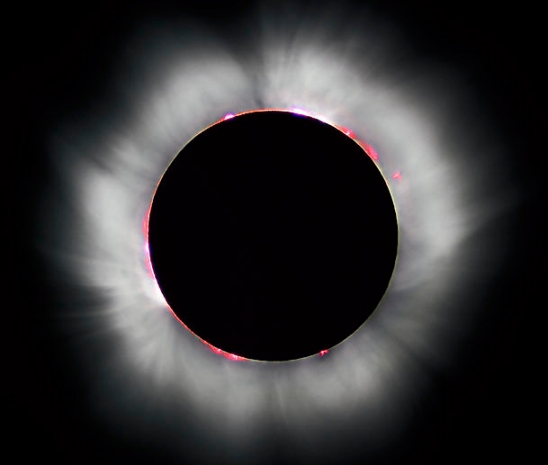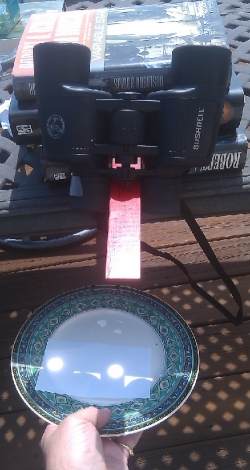
As most people are probably aware, there will be a total eclipse of the sun visible from many parts of the United States. It will occur on August 21st, but the exact times depend on where you are. I received a question about how to best enjoy it, so thought I would compile some resources to help people who are interested. First, you can find out exactly when to expect the eclipse by going to this website:
https://www.timeanddate.com/eclipse/in.html
If you put in your city and state, it will tell you when to start viewing the eclipse, when it will be at its maximum, and when it will end. In addition, it will tell you the magnitude, which is the fraction of the sun that will be blocked by the moon. If it doesn’t have your city, just add a comma and the full name of your state, and it will bring up several other cities in that state. Choose the one closest to you.
The next thing to make clear is that YOU SHOULD NEVER LOOK DIRECTLY AT THE ECLIPSE! The sun produces a lot of light; too much for your eyes to handle. As a result, when you look directly at the sun, the light-sensing cells in your eyes can be overwhelmed. If they are overwhelmed for too long, they can die. Even though the sun is a lot dimmer during an eclipse, it still produces too much light for your eyes. However, it isn’t as difficult to look at as the uneclipsed sun, so you don’t notice that you are overwhelming your light-sensing cells. This can lead to solar retinopathy, which can cause serious vision problems.
So how can you enjoy the eclipse? This website gives you several different ways to safely view it:
http://www.deepskywatch.com/Articles/how-to-look-at-sun.html

Interestingly enough, however, you don’t need to make something as complicated as the setup shown on the left or even a pinhole projection camera such as what is discussed in the link above. In fact, a plain kitchen colander will project multiple images of the sun. Just put a colander between a white surface and the sun, as shown in this video. The holes in the colander will project the sun on the white surface, and you can watch multiple images of the eclipse. Adjusting the distance between the white surface and the colander will adjust the focus of the images. Aristotle (384-322 BC) was the first to record this method of viewing an eclipse. He also noted that you can simply look at the ground under a tree that has broad leaves. You will see multiple images of the eclipse happening on the ground, as projected from tiny openings in the tree’s foliage. I confirmed this during the 1999 solar eclipse pictured at the top of this post.
If you decide to use the solar viewing glasses that have become popular, you should definitely test them before you use them. Even if they are made properly, they can be damaged during shipping and storage, and you don’t want to risk looking through damaged glasses. This site discusses how you can make sure your glasses are safe:
https://www.space.com/37698-solar-eclipse-glasses-safety-check.html
I would also recommend cupping your hands around the sides of the glasses to block out peripheral light.
I hope these resources will help you enjoy the eclipse safely!

Thanks for the resources! A couple added comments from someone who is borderline-obsessed about this event… 🙂
If you are able to be in the path of totality, you CAN safely take off your eclipse glasses while the sun is completely covered by the disk and view the corona and look for nearby Mercury, among other planets and stars. (You also might get to see the shadow of the moon racing towards you and a sunrise/sunset all the way around the horizon just before and after the totality.) But be VERY VERY careful to put them back on before the first flash of sunlight comes back to your eyes after your pupils have opened wide to adjust to the dark.
I also love how all the secular science articles and videos describe the sizes and distances of the sun and moon as a “coincidence”. While of course total eclipses don’t prove Christianity, and a lack of them wouldn’t disprove it, ever since I read in The Case For A Creator about the remarkable additional “coincidence” that total solar eclipses can only be observed on the one planet that happens to have observers, and the many scientific discoveries we’ve been able to make by studying them, I’ve always thought of it as a beautiful gift from the One who set the greater and lesser lights in their paths in the beginning. I also admire how our ability to precisely predict their paths down to the second, several decades in advance, illustrates the elegant order of our finely-tuned universe.
I typically don’t recommend looking at the sun even if the eclipse is total, just because it is too easy to ignore the light as the eclipse leaves totality. However, if you know what you are doing, it is safe.
If you deny belief in a Creator, you have to believe in all sorts of crazy coincidences. I suppose it just becomes routine…except when your friend keeps beating you at cards, of course.
I saw one in Costa Rica in the 90´s. For me the most impressive part was to see the night comming to you as the shadow covered the earth and the animals started to behave as if was night.
Enjoy it!
Ah! forget to mention the red flames appearing behind the moon in the dark night, I swear if i have not known in advanced the eclipse was comming I would died of a heart attack even as I was 18 then!!!
Great post!, thought I never hatched an eclipse.
Recently, I read an articule (in Portuguese) that I found interesting; especially the conclusion (already in English):”In the study carried out through literary review it can be concluded that by the method of
Carbon dating 14, it becomes possible for archaeologists to prove the age of
Objects and fossils found, which have probably been in place for thousands of years.
From what we can see, dating through carbon-14 should not be used as
The exact concentration of carbon-14 in
Times. This variation can make a sample look older than it actually
Can be.
It’s good to keep in mind what’s behind the carbon-14 dating methods. An
Thing is to measure the amount of isotopes present in a particular sample, this is
Do with great precision; It is quite another thing to extrapolate this observation to
Determine the age of the object in question, this depends on factors not observed and
That one simply has to assume can not go back in time until
That the object began to form and to accompany its development”
http://www.unifia.edu.br/revista_eletronica/revistas/gestao_foco/artigos/ano2011/gestao_foco_Carbono14.pdf
Thanks, Victor. I prefer that comments be related to the posts. I certainly agree with the authors’ conclusions.
Also, don’t forget to have your pendulums and gravimeters ready so we can continue to investigate the Allais effect !
“In a marathon experiment, Maurice Allais released a Foucault pendulum every 14 minutes – for 30 days and nights -without missing a data point. He recorded the direction of rotation (in degrees) at his Paris laboratory. This energetic show of human endurance happened to overlap with the 1954 solar eclipse. During the eclipse, the pendulum took an unexpected turn, changing its angle of rotation by 13.5 degrees.
Both before and after the eclipse, the pendulum experienced normal rotation (Foucault effect of 0.19 degrees/minute). This 13.5-degree excursion in the angular plane persisted throughout the length of the eclipse, a total of 2.5 hours of observations. Allais got similar results when he later repeated the experiment during a solar eclipse in 1959.”
https://science.nasa.gov/science-news/science-at-nasa/1999/ast06aug99_1